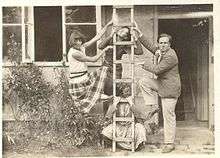Stephen Tomlin
| Stephen Tomlin | |
|---|---|
 Tomlin poses with his lover Dora Carrington in the 1920s | |
| Born |
Stephen Tomlin 2 March 1901 London, United Kingdom |
| Died |
5 January 1937 (aged 29) London, United Kingdom |
| Occupation | artist, sculptor |
| Notable works | Bust of Virginia Woolf, bust of Lytton Strachey |
| Spouses | Julia Strachey (1927–34) |
Stephen Tomlin (2 March 1901 – 5 January 1937) was a British artist associated with the Bloomsbury Set. He was the youngest son of the judge and Law Lord Thomas, Lord Tomlin of Ash. He studied at New College, Oxford, from January 1919, leaving after two terms to take up sculpture.[1]
Life
Tomlin studied classics at New College, Oxford from January 1919. However, he suffered a nervous breakdown following the death of a fellow student and left after two terms. He then became a pupil of Frank Dobson and later established a career as a portrait sculptor.[2]
Tomlin's circle of friends, and sitters for portraits, included many members of the Bloomsbury Group, particularly second generation members like Francis Birrell and David Garnett.
Tomlin was bisexual and had affairs with a number of members of the Bloomsbury set including Henrietta Bingham[3] and Dora Carrington. In 1927 he married Julia Strachey, niece of Lytton Strachey.[4] His relationships with men are less well attested, probably due to the necessity of concealing gay relationships which were at that time illegal in the United Kingdom under the Criminal Law Amendment Act. One of Tomlin's boyfriends, known as 'H', also had a relationship with the artist Duncan Grant.
Grant had a 'long friendship with ‘H’, who worked in the drapery department at the now defunct Jones Brothers’ department store on the Holloway Road. ‘H’ had been the boyfriend of sculptor Stephen Tomlin (who eventually married Barbara Bagenall), and when he and Tomlin had visited Lytton Strachey at Ham Spray in the 1930s ‘H’ had been obliged to sleep downstairs with the servants.'[5]
Tomlin co-founded The Cranium dining club with David Garnett, another member of the Bloomsbury Group, which met every month to exchange ideas.[6]
Tomlin died at the Royal Victoria Hospital Boscombe, Hampshire.
References
- ↑ Simkin, John (August 2014). "Stephen Tomlin". Spartacus Educational. Retrieved 22 May 2016.
- ↑ "Mapping the Practice and Profession of Sculpture in Britain and Ireland 1851-1951". sculpture.gla.ac.uk. University of Glasgow History of Art and HATII, online database 2011. Retrieved 22 May 2016.
- ↑ Chisholm, Anne (27 June 2015). "Good Stories of Bad Bloomsbury Behaviour". The Spectator. The Spectator. Retrieved 22 May 2016.
- ↑ Simkin, John (August 2014). "Stephen Tomlin". Spartacus Educational. Retrieved 22 May 2016.
- ↑ Watney, Simon (January 13, 2011). "Duncan Grant and Queer Bloomsbury". Charleston.org.uk. Retrieved 22 May 2016.
- ↑ "The Honourable Stephen Tomlin, Mapping the Practice and Profession of Sculpture in Britain and Ireland 1851-1951". sculpture.gla.ac.uk. Retrieved 22 May 2016.